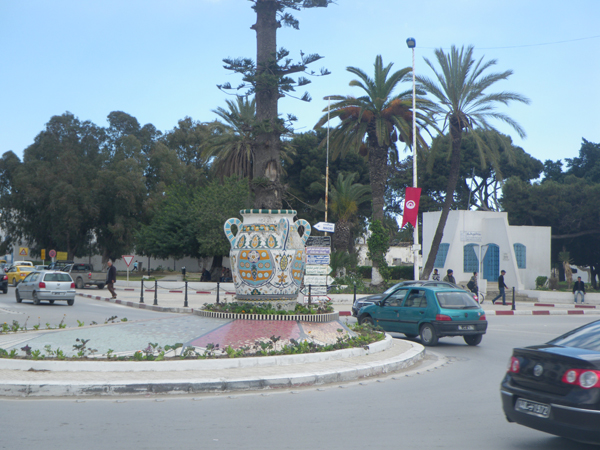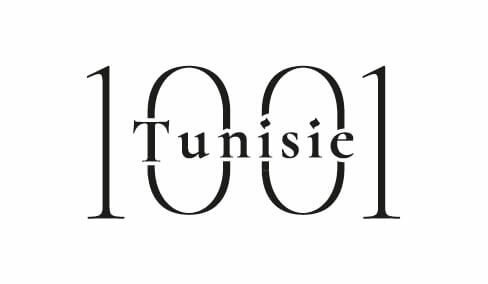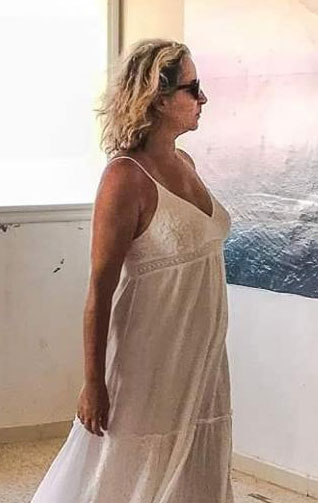
Nabeul is a coastal city located in the North East of Tunisia. 67 kms separating it from Tunis and some tens of kilometers of Hammamet. Capital of the most fertile region of the country, Cap Bon, Nabeul is renowned for its artisans, its sweetness of life and its many attractions.
The coast of Nabeul and its surroundings are also famous for their long sandy beaches and the succession of small coastal villages with crazy charm. Frequented by the local population, far from mass tourism, these villages with sweet names like Korba, Hammam Eguzzez, Maamoura make dream the true connoisseurs. Founded 2,400 years ago, Nabeul, Neapolis, is the city of North Africa the oldest mentioned by the texts after Carthage. 1001Tunisie takes you there.
9h00: Everyone or almost everyone knows the place of the Jarre, to have heard about it, to have crossed it or seen at least in photographic reportage or on television. Omnipresent in the life of the Nabeuliens, it became the lighthouse monument of the city. Its size competes with the magnitude of the impact it has on visitors who start their cameras as quickly. Unmissable stopover to approach the city, we propose to you to start by making a small stop in the coffee “l’Escale” history to take your breakfast there.
10h00: From the Place de la Jarre, leave your vehicle and go, just 50 meters on foot in direction of the sea on Habib-Bourguiba Avenue, to the Archaeological Museum of Nabeul. It is open every day except Monday, from 9:30 am to 4:30 pm in winter and from 9 am to 1 pm – from 4 pm to 7 pm in summer. The entrance is 5 TND. Composed of several rooms, some of which are devoted to Punic art (amulets, jewels, coins, statuettes) and a patio, the museum contains some beautiful Roman mosaics, one particularly well preserved from the excavations of the House of Nymphs 4th century AD).
10h45: Nabeul is a city attached to its traditions. That is what makes her charm. Its historical center “le Souk” is renowned for its craftsmen and the creations they exhibit there. Pottery, of course, has a special place. You will be surprised by what you are offered: porous, unglazed pottery, called “chawat” for water cooling and food preservation, red culinary pottery originating from Italy, enameled ceramic, utility or decorative, Traditional pottery, green and yellow, accompanied by brown motifs but which is becoming increasingly rare. Do not miss Habib-Thameur Avenue in front of the monumental door that marks the entrance to the pedestrian street the famous shop “Kharraz”, easily recognizable by its very original pottery. Take the time also to make a small detour by Souk el Balgha to visit Nessege, the workshop of the art weaver Omar Moussa. Household linen and foutas dispute the primeur and are declined in pleasant shades of warm tones. Rates range from 5 to 85 dinars and offer many gift possibilities.
The souk is also a nice place to eat. Friendly restaurants offer classic grilled chicken, egg bricks or couscous for ridiculous prices. Some terraces invite guests to sit for a coffee in the shade of an umbrella.
If you go to the end of the pedestrian street, you will be close to the side of “El Mahfar”. We suggest you visit the municipal souk. The markets are of course often more lively in the morning and this is perhaps an opportunity to make some provisions. Olive oil, orange flower, rose or geranium that make Nabeul famous, tuna … so many Tunisian products of great quality that you will be pleased to discover.
A little further on, there is the great mosque and the city of stone sculptors of “Dar Chaabane”.
12h30: To the west of the historic center, there is the “R’bat”, the city of nattiers. Old craftsmen such as Ferjani Hamali still make utility and decorative items such as cribs, placemats, nets, hats, bags, satchels, etc. in their workshops. The nabeulian mats are made from rods gathered at the beginning of The summer that can be dyed in different colors: yellow, burgundy green, purplish blue. With the baskets or baskets, the mats are the products of the best-known Nabeul handicrafts. They serve as floor mats or, more traditionally, cover the bottom of the walls.
Not far from its precious stalls, are the shops of the famous embroiderers of Nabeul. Still attached to their art, the old embroiderers of the district handle the thread and the needle and still use the craft to embroider “gorguef” and the cushion for the making of lace “chebka”, one of the finest lace in the world.
13h00: For lunch, we offer the “Bon Kif” located in the avenue Marbella, behind the Magazin General. We offer you typical cuisine and delicious fish-based specialties according to the Nabeulian tradition. You can also take your car, go to the exit of the city, in direction of Hammamet, the restaurant the “Slovenia”. The venue is run by one of Tunisia’s most renowned chefs, Rafik Tlatli. Try the “Couseila” a dish between couscous and paella. On the wallet side, count 18 TND per person for the Couseila, 12 TND for the pasta dishes, 23 TND for the grouper steak and 6 to 12 TND for the desserts. Slovenia is open every day of the week for lunch and dinner.
15h00: After a good meal, nothing like a little walk. Come and enjoy the cultural at your leisure, just a 15-minute walk from the Slovenia restaurant and the archaeological site of Néapolis. For the more lazy, park your car on the small parking lot in front of the entrance of the site. Located on the seafront on Avenue Mohamed V, the vast site of the site where the mimosas and gold buds bloom in spring, is open every day except Monday, in winter, from 9 am to 1 pm and from 2 pm to 5 pm and, in summer, from 9 am to 1 pm and from 4 pm to 7 pm. The entrance is 4 TND. Here you will discover an industrial complex from the Roman era destined to the manufacture of the salting and the garum of which Neapolis had made a specialty. Children can swim at ease without danger.
16h00: Back in the city center, on the side of the Avenue Habib-Thameur, do not miss the Center of Arts and Crafts, a craft village that brings together craftsmen in pottery, matting, wrought iron, embroidery. It is a mini innovation laboratory. Attention to schedules. Often open only in the morning.
16h45: Head to “Dar Taieb”. Located at the exit of Nabeul, on the road of Tunis, this small museum dedicated to the Arts and popular traditions of the region is an initiative of a child of the region, CEO of the companies Cérina Beauté and Kamy. The entrance to the Dar Taieb Museum is 2.5 TND. To see: the room “Bit El Mouna” and a Berber Bedouin tent, the “skifa El Aarbi”. A sales area for Cérina and Kamy products (essential oils, perfumes, cosmetics and spices) adjoins the museum.
Visiting Nabeul can not end without visiting the “Sidi Mahrsi” space, a cultural space containing updated and restored mosaic panels of great artistic value.
18h00: If you want to spend the night in Nabeul, there is no shortage of good addresses. Guest house Dar Om el Khair and Dar Sam welcome you like at home, Pension Les Oliviers is also a pleasant alternative to the hotel with its cozy 10 rooms overlooking a large garden planted with olive trees. For a prestigious stay, choose Dar Sabri or Dar Hirondelle, tailor-made rentals in the historic heart of Nabeul.
T.B.
{mainvote}















 َAbonnez-vous
َAbonnez-vous

